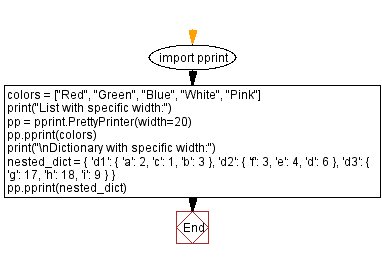Python pprint Exercise - Specify the width of the output while printing a list, dictionary
3. Pprint with Custom Width
Write a Python program that specifies the width of the output while printing a list, dictionary using the pprint module.
"width" (default 80) specifies the desired maximum number of characters per line in the output. If a structure cannot be formatted within the width constraint, a best effort will be made.
Sample Solution:
Python Code:
import pprint
colors = ["Red", "Green", "Blue", "White", "Pink"]
print("List with specific width:")
pp = pprint.PrettyPrinter(width=20)
pp.pprint(colors)
print("\nDictionary with specific width:")
nested_dict = {
'd1': {
'a': 2,
'c': 1,
'b': 3
},
'd2': {
'f': 3,
'e': 4,
'd': 6
},
'd3': {
'g': 17,
'h': 18,
'i': 9
}
}
pp.pprint(nested_dict)
Sample Output:
List with specific width:
['Red',
'Green',
'Blue',
'White',
'Pink']
Dictionary with specific width:
{'d1': {'a': 2,
'b': 3,
'c': 1},
'd2': {'d': 6,
'e': 4,
'f': 3},
'd3': {'g': 17,
'h': 18,
'i': 9}}
Flowchart:

For more Practice: Solve these Related Problems:
- Write a Python program that prints a long list and a nested dictionary using pprint, setting the width parameter to 50, and observe how the output format changes.
- Write a Python function that accepts any data structure and pretty-prints it with a user-specified width, then test it with different width values.
- Write a Python script to generate a dictionary with very long string values and use pprint to print the dictionary with a custom width that forces line breaks.
- Write a Python program to compare the output of pprint with different width settings for the same nested structure and document the differences.
Go to:
Previous: Sort the keys of a dictionary before printing it using the pprint module.
Next: Specify the indentation while printing a nested dictionary.
Python Code Editor:
Have another way to solve this solution? Contribute your code (and comments) through Disqus.
What is the difficulty level of this exercise?
Test your Programming skills with w3resource's quiz.
